FLIGHTS TO JAPAN
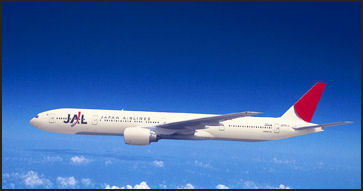
JAL plane Air fares in Japan are said to be among the highest in the world. One reason for this is the high landing fees at some of the airports. High fuel prices are another reason. For example, an economy seat on a round trip from Los Angeles to Tokyo on Japan Airlines costs nearly $1,300 per person in 2011, including nearly $600 in fuel surcharges.The flying time from New York to Tokyo is about 12½ hours, from Los Angeles about 10 hours. Flights going the other direction are about 1½ hours shorter Many of flights across the Pacific are non-stop; it is no longer necessary for the new Boeing 747s to stop in Alaska or Hawaii. Many flights from Europe fly over the North Pole.
National Carriers: Japan Airlines (JAL, JAL ), All Nippon Airways (ANA, ANA). Japan Airlines was ranked the No. 7 international airlines in the Travel and Leisure readers survey in 2002, 2004 and 2006. All Nippon Airways was ranked the No. 8 international airlines in the Travel and Leisure readers survey in 2004.
Major Cities with Connections to Japan: Flights arrive in Japan from 92 international cities and 39 countries. Most North American, European, Pacific and Asian counties have direct connections with cities in Japan. There are a few flights to Africa and South America. Major Airlines that Fly to Japan: Many airlines fly into Japan including United, Delta, American, Virgin Atlantic, Finnair British Airways, KLM, Lufthansa, Alitalia, Air France, Aeroflot, Turkish Airways, Gulf Air, Air, Kuwait Airways, Thai Air, Cathay Pacific.

ANA plane Air Safety: Airsafe.com Airsafe Air Crashes Record Office baaa-acro.com/ . Aviation Safety Network aviation-safety.net ; Aviation Accidents U.S. Departmen of Transportation ntsb.gov/ntsb/query. ; Air Claims Limited is a London-based aviation consulting firm that provided information on air safety. Seating Plans for Airlines: Seat Guru Seat Guru Tracking Flights: Flight Explorer . Distances Between Cities: Indo.com Indo, com Airport CodeS : Airport City Codes
Long Flights: Do exercises in your seat, drink lots of water, avoid alcohol, and periodically get up and move around to reduce the risk of getting "economy class syndrome" (deep-vein thrombosis, DVT), which occurs when a blood clot forms in the leg and moves to the brain, lungs or heart.
High and Low Season: Prices for plane tickets usually vary with the season. The low season is usually from early September to mid-December and from January through May. The high season is generally during late July and August — with the peak flying season from around July 22 to August 21 — late December, early January and around Golden Week (late April or early May). The mid season is generally in June and early July and early September. Each airline determines it own seasons but they generally follow this pattern. Prices vary between a US$50 to US$1000 for each season. For example a ticket from New York to Tokyo may cost US$700 in the low season, US$900 in the mid season and US$2000 in the high season.
Budget Airlines in Japan
A number of low-cost carriers — including Air Asia — are beginning to crack the Japanese market and helping to bring down ticket prices for international flights to and from Japan as well as domestic flights with Japan. Chinese discount carrier Spring Airways offers ¥4,000 one-way tickets between Ibaraki Airport, 80 kilometers north of Tokyo, and Shanghai for 10 percent of its 180 seats on each flight. The other seats go for between ¥6,000 and ¥26,000. Australia-based Jetstar and Airline are eying domestic routes in Japan. Jetstar offers one way flights between Tokyo and Cairns for ¥ 25,000.
Discount carrier Air Asia X began operating flights between Haneda Airport in Tokyo and Kuala Lumpur in Malaysia in December 2010, with some promotional seats selling ¥5,000 one-way. The usual ticket prices are between ¥14,000 and ¥68,000 one way. In August 2011, Air Aisa X began flying between Kuala Lumpur and Osaka four times a week with one-way fares as low as ¥8,000.
In July, AirAsia and ANA announced a joint venture on a low-cost carrier based in Narita that will begin offering domestic and international flights in August 2012. ANA will own two third of the airline, AirAsia, a third. The venture is in addition to ANA’s low-cost carrier, Peach airlines.
Japan Airlines, Australia's Qantas Group and Mitsubishi Corp. have agreed to jointly establish a low-cost carrier in September, with commercial domestic flights to start by the end of 2012. The new carrier, named Jetstar Japan, will offer customers a "best-price guarantee" of the cheapest fares among airlines flying the same routes, in the same time periods on the same days. Jetstar Japan will initially fly domestic routes connecting Narita and Kansai airports--its main operational bases--with such cities as Sapporo, Fukuoka and Naha and later offer international flights to key Asian cities.
Cheap Flight Websites:
Japan Travel from Europe Japan Travel No. 1 Travel for flights originating in Japan No. 1 Travel
Air Bookings Web Sites: Orbitz Orbitz Dohop Dohop Mobissimo Mobissimo ; Cheap Flights Cheap Flights ; Sidestep.com Sidestep ; Qixo.com Qixo ; Kayak.com Kayak ; Yahoo Travel Yahoo Travel ; Cheapticket.com Cheap Ticket ;Skyauction Sky Auction ; Expedia Expedia ; Travelocity Travelocity .
Cheap Flights
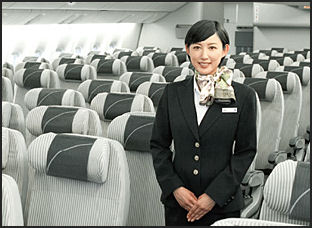
JAL economy class It is hard to get a cheap one way plane ticket to Japan. They best buys are generally for round trip tickets. Travel Agencies that sell cheap tickets are called "consolidators" in the United States and "bucket shops" in Britain. They make money by buying blocks of tickets at a cheap price and reselling them.
Be careful dealing with consolidators and bucket shops. Their tickets are usually laden with restrictions, their travel agents are skilled at putting people off and not coming through with tickets until the last minute. The bucket shops in London are worse than their counterparts in the States. For more information see Appendix VII on Cheap Flights.
Jetstar has cheap flights between Japan and Australia at around US$600 round trip. . It is the first foreign discount airlines to operate in Japan. JALways offers budget flights to resort destinations in Hawaii and Southeast Asia JAL Express plans to offer budget flights between China, South Korea and Japan in 2009.
From New York: A one-way ticket from New York to Tokyo is $400. A round-trip ticket is $500. Check out the ads in the New York Times Sunday Travel Section. From Los Angeles and San Francisco: A one-way ticket from Los Angeles to Tokyo is $350. A round-trip ticket is $400. Check out the ads in Sunday Travel sections in the Los Angeles Times and the San Francisco Chronicle.
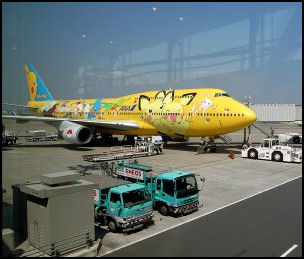
ANA Pikachu 747 From London: A round-trip ticket from London to Tokyo is about $500. There are also many cheap package tours. Many London bucket shops advertise in the London entertainment weekly Time Out. You can also try the Sunday editions of the British newspapers like the Guardian, the Independent or The Times. From Other Cities: Check out the Sunday Travel sections in the major newspapers in the cities from which you want to fly.
Package Tours and Charter Flights: Some package tours, including flight and accommodation to Japan, are offered from major cities in Europe and the United States. Packages tours to Japan are not as common or as cheap as package tours to other places. The tours are usually arranged by travel agencies.
In recent years there has been an increase in the number of charter flights between regional airports and international destinations such as Australia, Palau, the Marshall Islands, China, the United States and Canada. The flights have been set up as way to bring foreign tourist to places in Japan. Rules were passed in 2007 making is easier for charter flight operators to operate in Japan, opening the possibility of cheaper overseas travel to and from Japan.
AIRPORTS
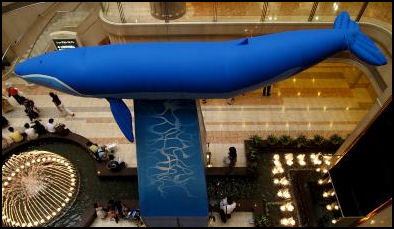
the whale at Haneda airport There are two airports which serve most international air traffic: Narita outside Tokyo and Kansai outside Osaka. International flights also arrive at Nagoya and Fukuoka airports and to a lesser extent at Okinawa, Hiroshima, Oita, Okayama, Kagoshima, Kumanoto, Nagasaki, Komatsu, Kanazawa, Niigata, Sendai, Takamatsu and Sapporo.
Tokyo only has two airports. Domestic flight in Tokyo generally arrive at Haneda airport. There are no night flights into Tokyo. The air space at Narita and Haneda airports is closed between 11:00pm and 6:00am.
There are three airports in the Kansai, Osaka, Kyoto and Kobe areas: Kansai Airport, Osaka Airport and Kobe Airport. The former is the main international airport for the area. The latter two are primarily domestic airports.
These airports have luggage storage, first aid stations, tourist information booths, hotel information booths and courtesy phones, shops, food outlets, bars, luggage trolleys, a lost and found, and currency exchange banks. Taxis from the airport can be prohibitively expensive. A good strategy is to take public transportation from the airport to the city center and then take a taxi from there to your hotel.
Airport Web site: Airwise Airwise offers reviews of airports, lists the airlines that fly there and provides information on local transportation, departure taxes, car rental services and arrival and departure times.
TOKYO AIRPORTS
Narita Airport (Offical Narita Site , about 40 miles from downtown Tokyo) is officially named the New Tokyo International Airport. It has luggage storage, sleeping rooms, an audiovisual room, relaxation rooms, showers, a large selection of restaurants and shops, playroom for children, first aid stations, tourist information booths, hotel information booths and courtesy phones, shops, food outlets, bars, luggage trolleys, a lost and found, and currency exchange banks. The departure tax for international flights is $16.75
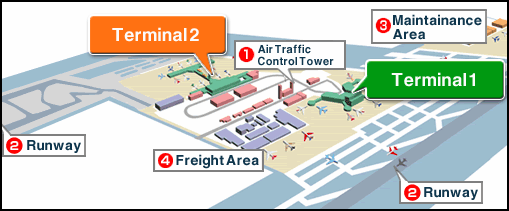
Narita map
As of 2007, Narita accommodated 35.48 million passengers on 1,552 flights a week from 94 cities in 40 countries. About half of the international flights in and out of Japan before the second runway was built. This figure may increase to 77 percent when the second runway is fully utilized.
Even though the Tokyo metropolitan area is the most populous urban area in the world it is still served mainly by one international airport, which until recently had only one runway that closed at 11:00pm every night because of noise restrictions. By contrast, other large cities such as London, Paris and New York are served by two, three or four airports, all with multiple runways often open 24 hours a day. Construction of Narita and plans to expand have been delayed for decades due to objections by local farmers, supported by leftists. Confrontation and violet protests over the airport led to six deaths, 15 suicides and the ransacking of control towers
Work began to extend the new second runway at Narita to 2,500 meters long — so it can accommodate jumbo jets — was completed in October 2009. The runway was extended north instead of south as was originally planned because the two farmers in the south continue to refuse to sell the few hectares of land needed to fulfill the original plan. The new plan will take six years and ¥33 billion to complete, twice the cost and time needed to build the extension south. Narita’s Runway A is expected to become fully operational in 2012.
To better compete with Haneda, Narita is planning a big expansion that will involve the construction of a new terminal for low-coast carriers. Even with competition from Haneda, some expect the number of takeoff and landing slots to rise from 220,000 a year in 2010 to 300,000 in 2014. In the summer of 2010, Narita began offering free Internet access.
Transportation from Narita Airport: There are five ways to get from Narita airport to Tokyo: 1) Airport Limousine Buses (good if you have a lot of luggage) are parked in front of the arrival lobby and they go to downtown Tokyo hotels and some other locations. They costs about US$25 to US$30. 2) The airport shuttle bus service, which takes passengers to downtown Tokyo hotels, has a ticket counter in the arrival area.
In the summer of 2010, Narita began offering faster trains. The new Narita Sky Access train service began in 2010, reducing the time between the airport and downtown Tokyo to 40 minutes.
3) Japan Rail (JR) Trains, operating from a station under the terminal building, run into downtown Tokyo. The trip take about 70 minutes and costs about US$25.
4) Keisei Trains, also with a station under the terminal, are simpler and faster than the JR train and only cost about US$15. The journey takes about an hour. They leave from Keisei-Ueno and Nippori stations in downtown Tokyo. 5) A taxi to downtown Tokyo will cost about US$140 or more. There is some discussion of installing an airport maglev train between Narita and Haneda airports. Website: Narita official site transportation

Haneda Airport (Haneda Airport Site about seven miles from downtown Tokyo) in Tokyo is Asia’s busiest airport. Primarily a domestic airport for Tokyo, Haneda counted 67 million passenger arrivals and departures in 2007, making the world’s forth busiest airport behind Atlanta’s Hatfield-Jackson Chicago O’hare and London Heathrow. The vast majority of the flights are domestic flights. Haneda handles 303,000 take offs and landings a year. That figure is expected to rise to 447,000 a year in 2013. About 170,000 people use Haneda Airport daily. During peak hours, 50,000 visitors and workers are at the airport, while about 100 airplanes are on runways and aprons.
The new international terminal and runway at Haneda opened in October 2010. Japan Airlines, ANA, Delta, British Airways and American Airlines offer service to several foreign destinations, including Paris, New York, Los Angeles, Detroit, London, Bangkok, Beijing , Seoul, Hong Kong, Singapore and Honolulu. Haneda will handle 60,000 international flights a year, 30,000 during the daytime and the rest from late night to early morning. Flights from Haneda to the U.S. and Europe will be limited to late at night and early morning when flights at Narita are not available. In 2013 an additional 30,000 flights will be added. Five U.S. Airlines have applied for Haneda slots — Delta, American, United, Continental and Hawaiian Airlines.
The new international terminal is five stories high and has 154,000 square meters of floor space. The arrival lobby is on the second floor. The departure lobby is on the third floor. The Tokyo Monorail arrives at the third floor station and is one minute walk from the check in counter. On the forth floor is a Edo-period-themed shopping mall and dining area. On the fifth floor is a viewing deck and planetarium. The second floor has facilities for travelers to take a nap and a shower. The shopping mall has been such a hit that it has become a tourist attraction in own right and is used by people who not even taking a flight. On weekend sightseers often outnumber passengers by two to one.
Haneda began offering international service in 2004 — to Seoul. A new international terminal that primarily serves ANA flights was opened up that year. Haneda airport has excellent facilities and is near central Tokyo. It is only a few miles from Ginza and is much easier to get to than Narita. Politics have kept it from being utilized for international flights. Construction of the 4th, 2,500-meter-long runway at Haneda Airport began in March 2007 and was in 2010. It accommodates international flights and increase the capacity of airport 40 percent to 410,000 take-offs and landings a year.
Transportation from Haneda Airport:Haneda is well connected to Tokyo by Tokyo Monorail or the Keihon Kyuko Line. Perhaps most convenient art the buses that line up outside the arrival area that offer direct service to various destination all over the Tokyo area for between between $10 and $15. To travel between the new international terminal at Haneda at the terminals that handle domestic flights one has to take regular train service on either the Tokyo Monorail or the Keihon Kyuko Line — both of which will offer free tickets for international transfers for people who show their tickets. Free buses will also travel between the terminals. Website: Haneda Airport Access Haneda Airport Access
OSAKA, KOBE AND NAGOYA AIRPORTS
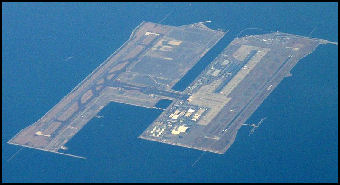
Kansai International Airport (Kansai official site 15 miles outside downtown Osaka) is the world's most expensive airport and one of the most ultra-modern ones. Built three miles offshore on a 1,250 acre artificial island at a cost $14 billion, it opened in 1994 as was declared one of the greatest engineering achievements of the 20th century by the American Society of Civil Engineers along with the Empire State Building, Panama Canal and Golden Gate Bridge.
The mile-long arched terminal at Kansai Airport was designed by the famed Italian architect Renzo Piano. It features huge drapes on the ceiling that direct air though the airport, a large multi-level shopping area, glass elevators and suspended walkways. Across from the terminal is hotel. A 3,750-meter-long double decker bridge connects the Osaka with the airport. The upper level is for vehicles and the lower level is for electric trains. To pay for all this and repairs caused by the airport sinking the airport charge some of the world’s highest landing fees and departure taxes ($22).
The new 4000-meter-long second runway — the longest in Japan and considerably longer than Kansai’s first 2,500-meter-long runway — opened at Kansai in 2007. Built on a new reclaimed area about the size of the first, it has been criticized for being too expensive and too far away from the terminal. Requiring planes to taxi for six kilometers and 10 minutes to reach the terminal. Construction of the second terminal to go with the new runway has been delayed.
Kansai is known in some circles as the world’s most expensive airport.Landing fees at Kansai are the world’s highest, and 50 percent higher than those at Narita. Some airlines — including American, United and Air Canada — have discontinued routes to Kansai. To make up for a lack of passengers Kansai is trying to market itself as cargo delivery hub and attract more planes from Asia, particularly China. To get more airlines to come Kansai has cut its landing fees by 80 percent from ¥580,000 to around ¥100,000, compared to ¥170,000 at South Korea’s Inchon Airport. In 2009 the Japanese government decided to cut grants to Kansai Airport. The mayor of Osaka responded by suggesting one solution to the controversy over where to locate an American military base was to put it at Kansai airport.
Kansai and Osaka (Itami) airports formed an alliance in 2010 to cooperate and organize their air routes so they complement each other rather than compete. Kansai Airport has cut is fees and has began to attract budget international airlines such as Air Busan, Star Flyer and Jeju Air, which flies to South Korea, Jet Airways which flies Australia, Cebu Pacific Air, which flies to the Philippines Air Asia began offering cheap flights from Kansai to Kuala Lumpur, Perth and Bali in 2011.
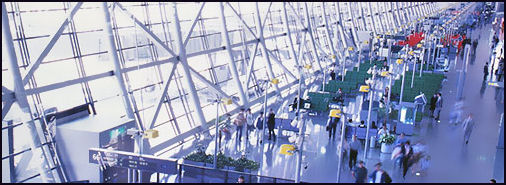
Transportation from Kansei Airport to Osaka: Kansei International Airport has a JR station at the airport (tickets are around US$10 to most destinations). Airport limousine buses, costing about US$8, run regularly to hotels and other destinations in Osaka and taxis cost about US$40. Website: Kansai Official Site Transporation
Kobe International Airport (Kobe Airport Site) opened in Kobe in February 2006, bringing the total of airports in the Osaka area to three. Like Kansai Airport, it is built on reclaimed island in Osaka Bay. It has a 2,500-meter-long single runway capable of handling jumbo jets and is connected to the mainland by bridge. Service began with 54 daily flights to seven destinations in Japan by JAL, ANA and Skymark Airlines. The airport cost more than $2 billion and left Lobe city deeply in debt,
Kobe Airport was built for $3 billion on a 272-hectare artificial island and was used by 2.74 million passengers the highest number if any municipal airport in Japan. After Kobe Airport opened there were a number of incidents involving planes colliding with birds. Many reclaimed plots near the airport have yet to be sold and have become nesting areas for sea birds such as little terns which have been involved in most of the bird strikes.
Transportation from Kobe International Airport: Unmanned Portliner trains connect the airport to Kobe’s Sannonmya station, which is served by JR and other train lines. Thirty-minute boats connect Kobe and Kansai airports. Website:Kobe Airport AccessKobe Airport Access
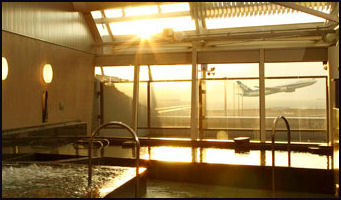
watach the planes take off
while taking a bath Chubu Centrair International Airport (Chubu Cebtair) opened outside Nagoya in February 2005. It is built on a manmade island off Tokoname in Aichi Prefecture and aims to be an international hub and the third major airport in Japan after Narita and Kansai. It opened with 293 international flights, including cargo flights, and 94 domestic flights. It is located far enough from major residential areas that it can operate 24 hours a day.
Chubu Airport has duty-free shops, shopping arcades, a wide choice of restaurants and even a garden with a wedding venue and baths where one can watch planes land and take off. The airport was very popular with Nagoya residents who visited it as a tourist attraction and a place to enjoy a meal.
Transportation from Nagoya Airport to Nagoya: Chubu Centrair International Airport is well connected to Nagoya by train using railway station that enters right into the check-in lobby so travelers don’t have to deal with any stairs. The Meitetsu Airport Bus in Nagoya cost less than $10. It connects the international airport with Nagoya Station. Taxis between the airport and downtown Nagoya cost about $40. Website:Chubui Centair AccessChubui Centair Access
FERRIES TO AND FROM JAPAN
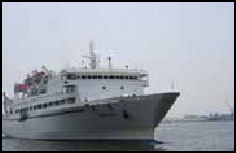
Kobe-to-China ferry Check Randy’s “Favorite Getaways to Rural Japan” Randy’s Ferries to Japan
Ferry Between Japan and Korea: There is a daily eight-hour ferry between Pusan, South Korea and Shimonoseki Japan (US$70-$140 one-way) as well as daily three-hour hydrofoils between Pusan and Hakata (US$85-$180 one-way). A ferry between Pusan and Kobe/Osaka (US$180-$260 one-way) operates in each direction twice a week.
A new ferry service between Kitakyushi, Japan and Pusan, South Korea was launched in June 2008. The previous service that operated between the places was terminated in 2004 because the operator went bankrupt. Websites:Japan Visitor, Seat 61 Korea Tourism
Ferry Between Japan and China: China-Japan ferries include one between Kaohsiung, China and Naha, Japan (US$150-$250 one-way), Shanghai to Kobe/Osaka/Yokohama (US$230-$570 one-way), and Tianjin, China to Kobe, Japan (US$290-$1500).
Two ships per week leave from Osaka Nanko for Shanghai. Economy class tickets for the 50 hour journey coast ¥20,000 one way and ¥30,000 round trip. Each weekly ship is operated by a different company. If you get a round trip ticket remember you have to take a ship from the same company both ways. For information in Japan call Shanghai Ferry (☎ 06-6243-6345) or Nitchu Kokusai Ferry (06-6536-6541). Websites: Seat 61 ; typepad.com ; Lonely Planet Thorntree
Ferry Between Japan and Russia: Flights between Vladivostok, Russia and Niigata, Japan cost about US$1,000 round trip. Boats to Vladivostok leave from Niigata on the second and third Fridays in June and from Fushika on the last Friday in June and first Friday in July. This pattern of alternating ports every two weeks is repeated until Oct 21. Trip takes 40 hours and cost between US$280 and US$730. Return Boats leave Vladivostok on Tuesday. For more information contact Jiero Travel Agent Kta Shijo Nishi, 7-1-5 Chuo-ku, Sappori-shi, Hokkaido, Japan ☎ (8111-281-0216, fax (8811) 281-0201.
From late April to early September, ferries operate between Otaru on Hokkaido and Kholmsk on Russia's Sakhalin Island and between Wakkanai on Hokkaido and Korsakov on Sakhalin Island. There are cruise boat services between Yokohama and Vladivostok. Some tourists use this system to link up with the Trans Siberian Railway.
The ferry between Toyama, Japan and Vladivostok, Russia is very expensive, with prices ranging between $300 and $550 for a berth. The ferries leave Japan on Wednesday and Friday at 4:00pm and arrive after two nights at 9:00am. The schedule can be disputed by bad weather. Website: Website: Seat 61; ; Way to Russia
Taiwan: There used to be a weekly ferry between Naha, Okinawa with Kaohsiung run by Arimura Shangyo but this was discontinued in June 2008 Taiwan.
North Korea: North Korea's only link to a non-Communist country is via the Mangyoungbong-92, a 400-foot, 300-passenger ferry boat that travels between Wonsan, North Korea and Niigata, Japan three times a month.
The vessel is mainly set-up for Korean residents of Japan traveling to North Korea, who are supposed to bring with them high-tech items such as computers or large amounts of foreign currency which is badly needed in North Korea to purchase foreign goods. The glistening white ship was built by Korean residents of Japan who are loyal to Pyongyang.
Most of the passengers are elderly ethnic Koreans visiting their families or graves of their ancestors or students on field trips organized by schools in Japan affiliated with North Korea. It is for all intents and purposes impossible for a non-North Korean or non-Japanese-North Korean to take this ferry
CRUISE SHIPS: see Appendix
Image Sources: 1) 3) JAL 2) ANA 4) 5) Ray Kinnane 6) Narita Airport 7) Haneda Airport 8) Wikipedia 9) Kansai Airport 10) Centair Airport 11) Kobe-China ferry
Text Sources: New York Times, Washington Post, Los Angeles Times, Daily Yomiuri, Times of London, Japan National Tourist Organization (JNTO), National Geographic, The New Yorker, Time, Newsweek, Reuters, AP, Lonely Planet Guides, Compton’s Encyclopedia and various books and other publications.
